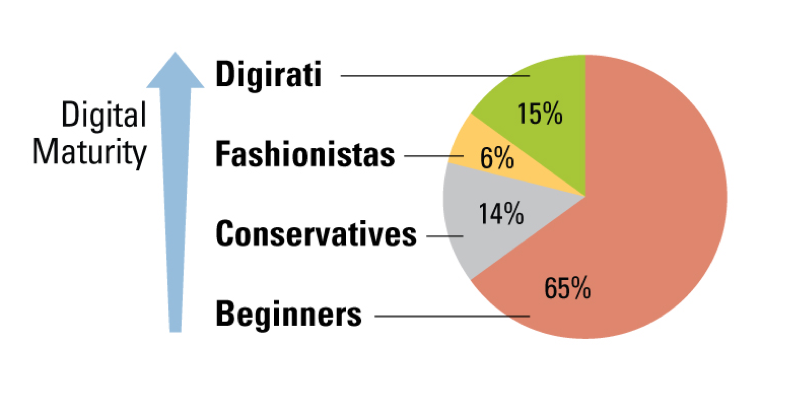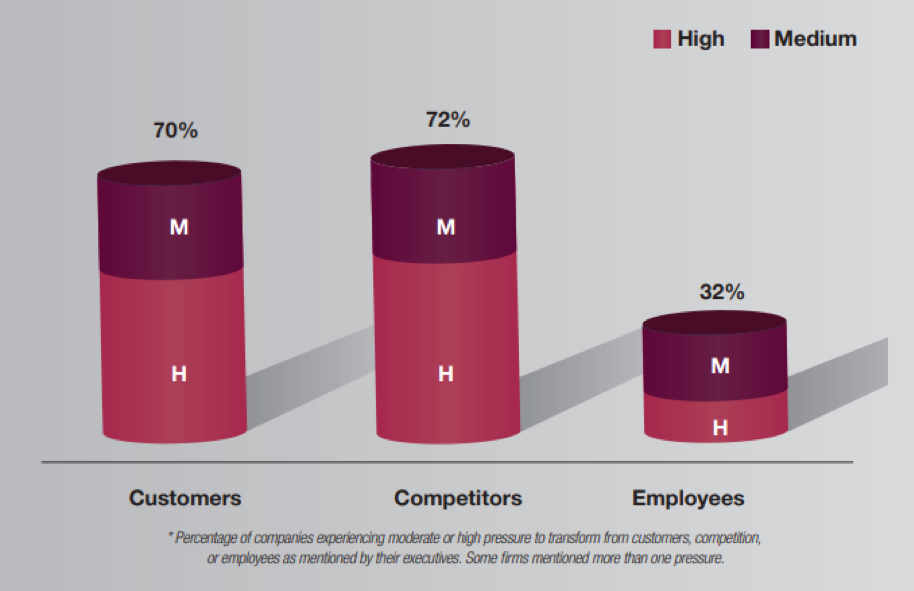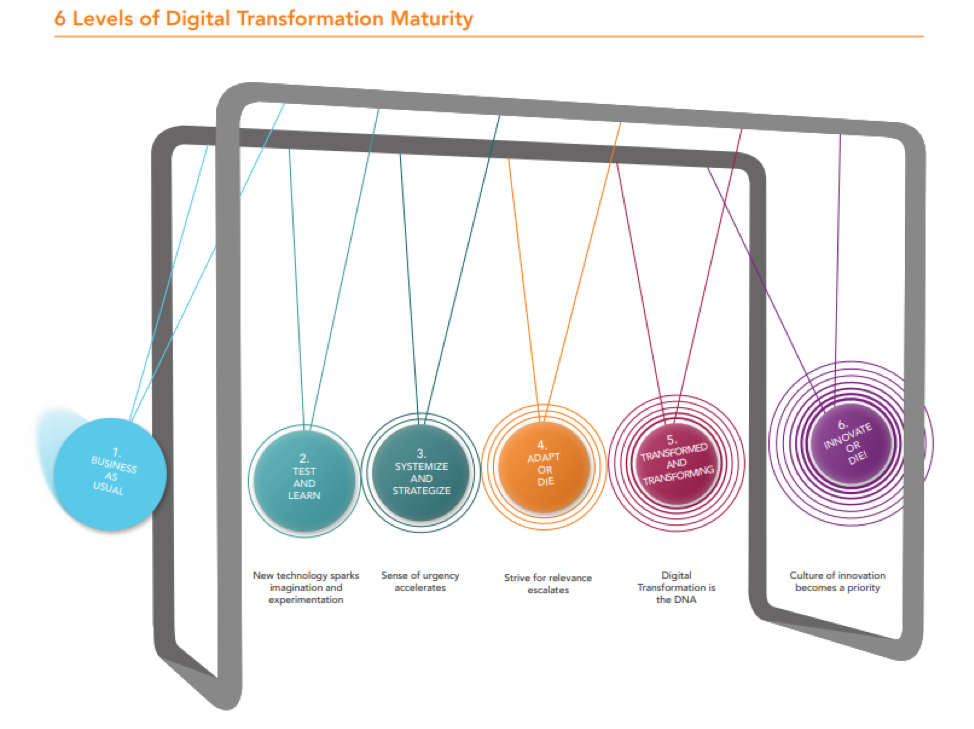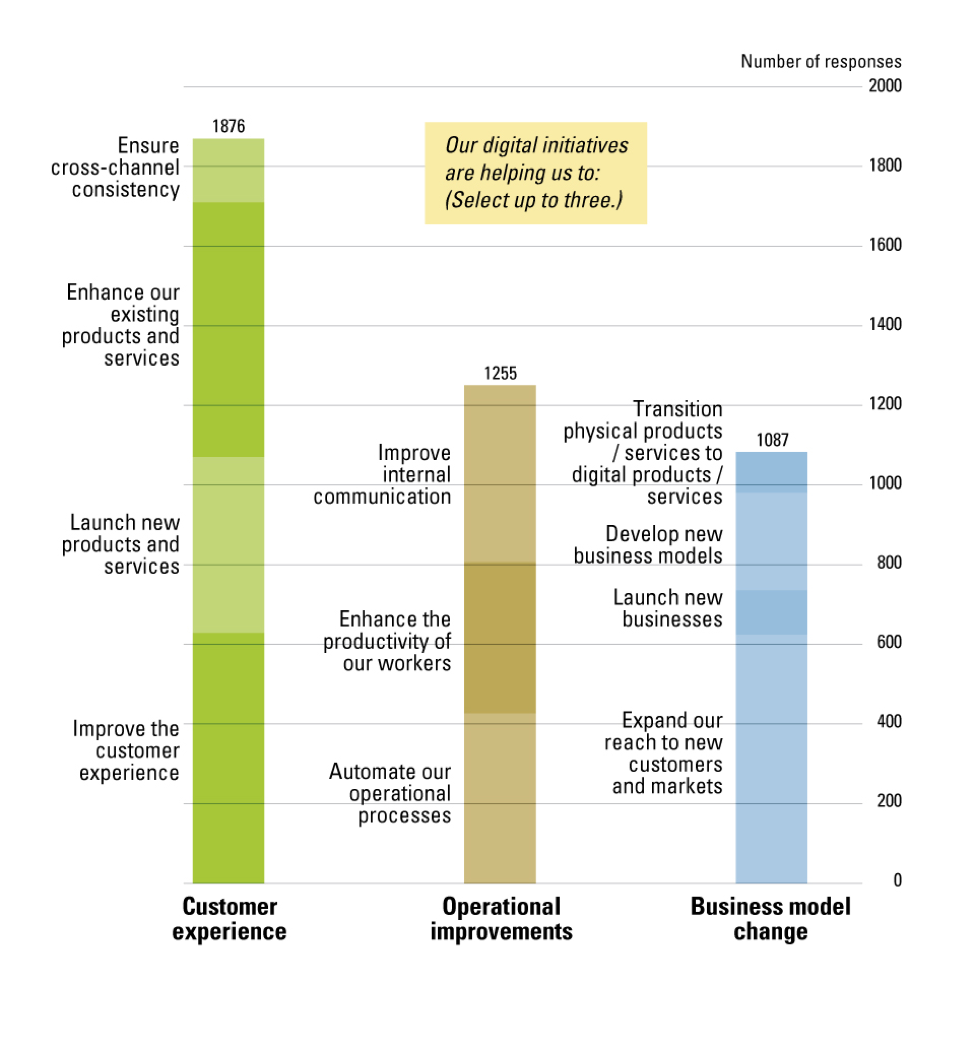Merriam Webster defines “transformation” as a “change in form, appearance or use.” Thesaurus.com takes it up a notch and calls transformation “a complete change.” By extension, digital transformation, then, is a complete change in the form, appearance or way in which an organization uses digital technology.
No company that continues to thrive and compete can afford to ignore change. Whether incrementally or abruptly, all organizations adapt and update their technology over time, often without even realizing it. The process of digital transformation is a deliberate, well thought-out, planned method of completely changing the technology used (or the way it is used).
Research from MIT Sloan found that 63% of executives feel that the technology in their organization changes too slowly. They cited a “lack of urgency” in organizational mindsets as a major barrier to digital transformation.
That study categorized the vast majority of businesses surveyed as “beginners” in their digital transformation journey, with just 15% on the path to a proactive and strategic digital transformation that was recognized, adopted, and sustained across all levels in the organization.

Source: MIT Sloan Management Review
Why Bother with Digital Transformation?
So what makes the biggest and most influential companies undertake this journey of digital transformation? Two things: customers and competitors. These twin factors play almost equal roles in pushing companies out of their existing comfort zone and induce them to more risks.

Source: Capgemini Consulting
In an effort to stay “ahead of the technology curve,” companies often unwillingly embrace the road to digital transformation. They do recognize, however, that not doing so would mean a loss of market share, customer loyalty and eventually growth.
However, the benefits are far-reaching. Enterprises stand to benefit drastically from modernization of their data centers and infrastructure, including minimizing downtime in operations and boosting business ability to sell solutions while controlling IT costs.
The Nutanix whitepaper on Datacenter Modernization with Hyperconverged Infrastructure explains how ten large organizations simplified their IT environment. They successfully right-sized infrastructure, improved agility in delivering end-to-end solutions, and grew business by adopting and scaling unified cloud computing solutions.
Milestones on Your Digital Transformation Journey
Each organization’s journey is different, with unique challenges, competitive landscapes and constraints that aren’t typical. However, there is a predictable path and certain patterns that most organizations follow on the way toward true digital transformation.
Starting from a zone of denial and inertia, organizations slowly move along the acceptance curve and get actively involved in revolutionizing the way they see and handle technology in their day-to-day lives.
A study by the Altimeter Group and Cognizant pegs digital transformation as a six-step process, where organizations become increasingly mature on the digital evolution scale as they move up every successive level.

Source: Cognizant
Business as Usual
The most digitally under-developed organizations fall into this category. They do not believe in rocking the boat and are complacent with the way things are. Technology is not seen as an enabler to growth but a mere tool to accomplish tasks. The customer experience is rudimentary as there exists no “one view” of the customer and each department works in its own individual silo.
The basic understanding that digital transformation can turbocharge organizational growth does not exist; small, incremental, Darwinistic changes are the only ones allowed to foster.
It’s important for businesses to identify their transformation objectives and rethink their business models keeping in mind the customer experience. Some of these goals could include:
Differentiate offerings by improving end user experience and improving the supply chain
Simplify service management by preventing and solving issues in real-time
Use data and analytics to improve operational agility as well as optimize infrastructure to improve efficiencies
Test and Learn
At this stage, there are stirrings within different parts of the organization. Individuals and teams get curious about the potential that newer technologies hold and start experimenting with how these fit into their current processes and patterns of work. Technology champions emerge within different departments, encouraging them to push the boundaries and challenge accepted beliefs. The organization starts investing in research and starts backing training programs for specific team members to slowly head towards a modernization.
However, each group still works in silos. No data or insights are shared between teams, making the learnings shortsighted and lacking impact. The organization is also slightly wary of the “rogue experiments” that technology champions undertake that have the potential to backfire and regress the company back to its old stance on technology.
Businesses in this stage can investigate technology enablers in the market, including marketing automation, AI, IoT, as well as security essentials that enable transition of data and applications to the cloud.
Systemize and Strategize
The organization starts taking notice of the push for change across different departments. There is now a concerted effort to improve and grow the digital capabilities of the organization. Task Forces led by executive sponsors are created to lead the charge.
Data driven, big picture thinking starts to take root. Developing digital literacy and expertise becomes a key priority across teams and the organization formally explores ways and means to achieve this goal.
Businesses in this stage would typically have adopted a highly virtualized, unified platform that improves mobility and productivity and enhances the digital customer experience. The Cloud Game Changers report by Nutanix reveals how companies like Hyundai, Nasdaq and JetBlue increased availability of their tier-1 applications, reduced their datacenter footprints, reduced system upgrade and maintenance times to a matter of few hours, and lowered costs in excess of 50%.
Typically, the first changes are seen in improving customer satisfaction, as marketing formally joins hands with IT to leverage more digitally enabled solutions. These solutions map the customer journey from end to end, crunch data and offer insights into how to improve the customer experience. As the organization starts to see results from their digital investments, they become more excited and committed to the path of digital transformation.
Adapt or Die
The digital way of life takes root in the organization and digital transformation across departments becomes the rallying cry. Experimentation moves beyond marketing to other functions in the organization like manufacturing, HR, customer service and more to make the embrace of technology more complete. The organization creates strategic roadmaps to achieve their goals with digital enablement as their backbone. Systems and data are shared across teams to strengthen insights and offer more robust results.
In this stage, just innovation and marketing are no longer sufficient for the business – it needs to master the digital services lifecycle with agile production and marketing methods, intelligent automation, DevOps, and digital service management. These will be the key competencies that enable businesses to achieve and sustain a competitive advantage in their industries.
The key indicators that an organization is adapting and evolving quickly include:
Less dependence on IT specialists
One-click management of applications that enable routine operational tasks
A single OS across all multiple hardware platforms and locations
Quicker deployment of new technology
Transformed and Transforming (And 6. Innovate or Die)
The digital transformation that the organization worked towards for so long finally bears fruit. Digital transformation infuses the very fabric of the organization’s ethos. The organization operates as a more unified organism with digital transformation helmed by a cross-functional governing body.
“Our technical specialists were seen as mechanics,” said Alessandro Rossi, head of ICT Secure Infrastructure at Leonardo. “Now they are able to think, to appreciate and evaluate a business case; they have evolved a lot.”
ICT, a leading aerospace and defence company, consolidated their data centers using the Nutanix Enterprise Cloud Platform and achieved greater flexibility without vendor lock-in in the process. They were also able to run mission-critical workloads spread across different geographical locations.
Learning and innovation become necessities instead of good-to-haves. The organization’s culture too transforms from a traditional, hierarchical system to a flatter, more interdependent structure. Innovation becomes the lifeblood of the organization, propelling forward new developments in production, distribution, and customer experience. Innovation centers form within the organization aimed at identifying new business opportunities, new markets, recruiting fresh talent, and more.
The Continuing Benefits of Digital Transformation
Very few companies have succeeded in achieving true digital transformation; quite a few are dragging their feet due to lack of conviction or resources, or both. In this scenario, what does digital transformation even offer to make the whole process worthwhile?
The MIT research cited earlier found that digital transformation had three primary areas of impact:
Customer experience
Operational excellence
Business model change
Even though a makeover to the organization’s business model may be the ultimate ambition for digital transformation leaders, the most common impact it had was on productivity, internal communications, and operational efficiencies overall.
A stronger connection with the digital-first consumers is the biggest benefit. Digitally transformed organizations converse and build relationships with their consumers, wherever customers are most comfortable.
Another aspect of these new digital capabilities is the ability to reach more customers and new markets, like selling via social media, buy-online-ship-to-store and more.

Source: MIT Sloan Management Review
Digital transformation is not by any means an “IT initiative.” Unless the entire organization is aligned to the process, nothing really is achieved. Digital transformation is a paradigm-shifting, reality-bending experience where old, tried and tested ways are abandoned in favor of the new, bold, and innovative.
Featured Image: Pexels
Dipti Parmar is a contributing writer. She has written for CIO.com, Entrepreneur, CMO.com and Inc. Magazine. Follow her on Twitter @dipTparmar.
© 2019 Nutanix, Inc. All rights reserved. For additional legal information, please go here.
